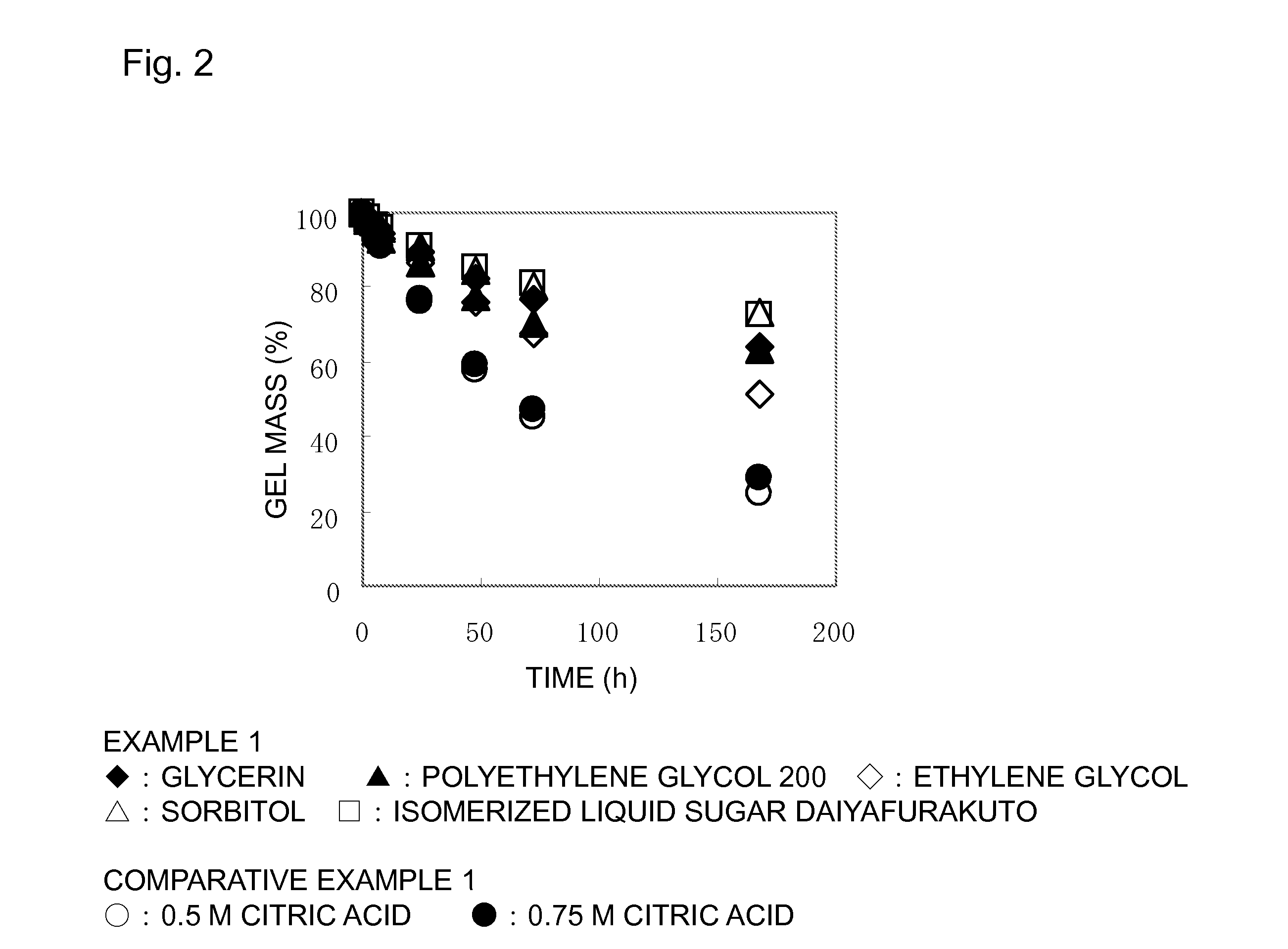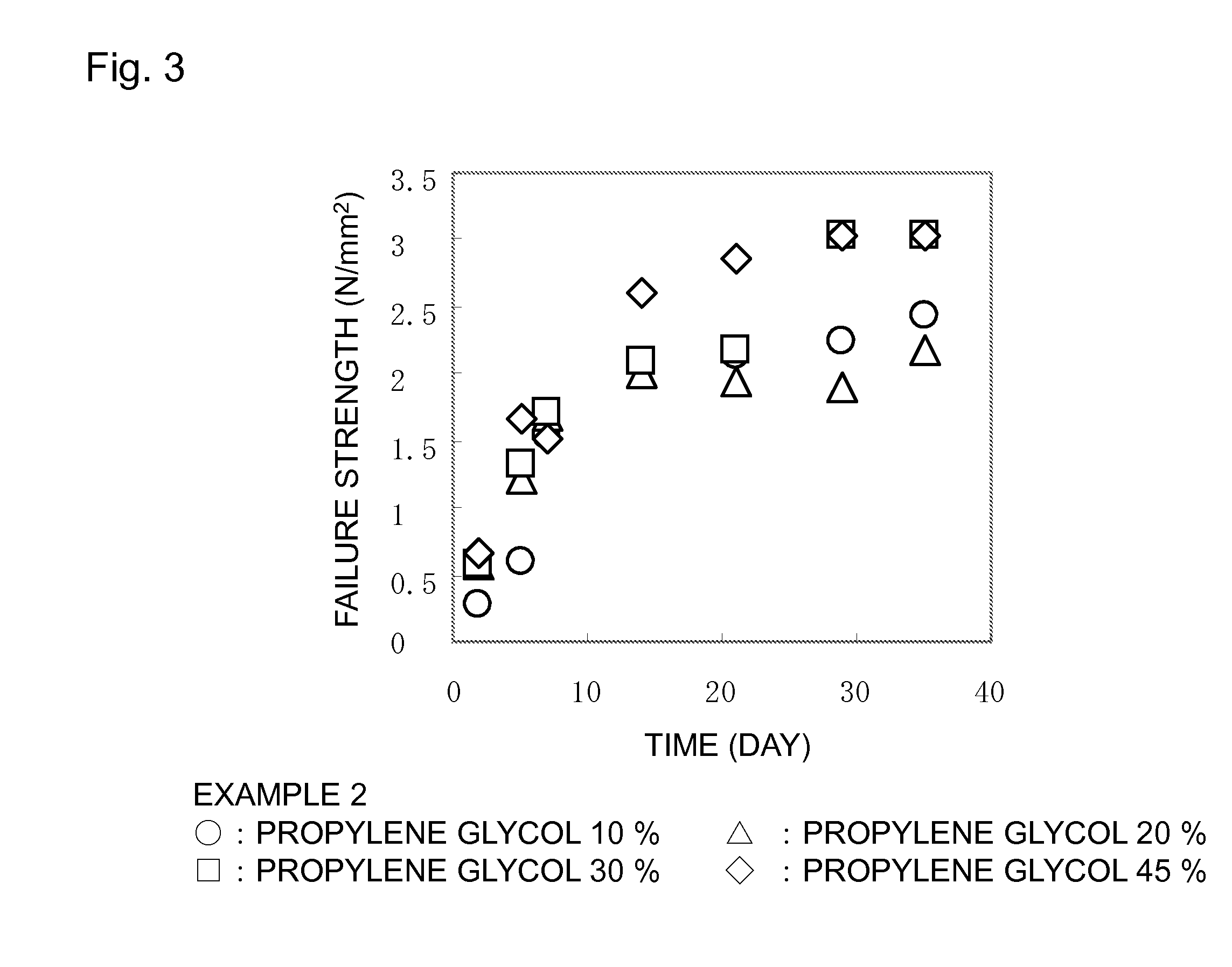Process for producing gel of carboxymethyl cellulose alkali metal salt
a carboxymethyl cellulose and metal salt technology, applied in metal/metal-oxide/metal-hydroxide catalysts, organic compounds/hydrides/coordination complex catalysts, etc., can solve the problems of difficult gel production and lack of simplicity, and achieve excellent water retention, high elasticity and strength, the effect of obtaining cheaply and simply
- Summary
- Abstract
- Description
- Claims
- Application Information
AI Technical Summary
Benefits of technology
Problems solved by technology
Method used
Image
Examples
example 1
[0055]Commercially available CMC (CMC1380, manufactured by Daicel Chemical Industries, Ltd., degree of etherification: 1.36, viscosity of an aqueous solution thereof having a concentration of 1% by mass at 25° C.: 1,640 mPa·s), a water retention agent, and a citric acid aqueous solution were mixed in a composition shown in Table 1. Specifically, CMC and the water retention agent were previously mixed, and subsequently, the obtained mixture of CMC and the water retention agent was mixed with the citric acid aqueous solution. After mixing, a sample was molded in a columnar form having a diameter of 2 cm and a thickness of 1 cm, charged in a hermetic container, and then stored at 30° C. for 10 days.
[0056]Thereafter, the sample was classified into three groups, and each five specimens were placed on a Petri dish and stored at 20° C., 30° C., and 50° C., respectively under a ventilation condition, and a variation of mass of the sample was examined.
example 2
[0060]Commercially available CMC (CMC1380, manufactured by Daicel Chemical Industries, Ltd., degree of etherification: 1.36, viscosity of an aqueous solution thereof having a concentration of 1% by mass at 25° C.: 1,640 mPa·s), a water retention agent, and a citric acid aqueous solution were mixed in a composition shown in Table 2. Specifically, CMC and the water retention agent were previously mixed, and subsequently, the obtained mixture of CMC and the water retention agent was mixed with the citric acid aqueous solution. After mixing, a sample was molded in a columnar form having a diameter of 2 cm and a thickness of 1 cm, charged in a hermetic container, and then stored at 30° C. Incidentally, the respective samples of Example 2 were prepared in such a manner that the amounts of citric acid were equal to each other.
TABLE 2Gel compositionWater retention agentCitric acid aqueous solutionExample / BlendingBlendingSymbol inComparativeCMC1380amountConcentrationamountFIGS. 3 and 4Exampl...
example 3
[0065]A compression modulus (5, 10 N) of the gel composed of 10% by mass of CMC 1380, 30% by mass of propylene glycol and 60% by mass of a 0.75 M citric acid aqueous solution as prepared in Example 2 was measured by compression using a compact table-top universal tester, EZTest (EZ-L), manufactured by Shimadzu Corporation and using a stainless steel-made compression jig having a diameter of 5 cm at a rate of 2 mm / min.
[0066]Incidentally, in a stress-strain curve, in the case where the strain at the time of a stress of 5 N and 10 N is defined as S5 and S10, respectively, the compression modulus (5, 10 N) is one obtained by dividing a difference in stress (10 N−5 N) by a difference in strain (S10−S5) and expressing the resultant value per unit area.
PUM
| Property | Measurement | Unit |
|---|---|---|
| temperature | aaaaa | aaaaa |
| viscosity | aaaaa | aaaaa |
| thickness | aaaaa | aaaaa |
Abstract
Description
Claims
Application Information
 Login to View More
Login to View More - R&D
- Intellectual Property
- Life Sciences
- Materials
- Tech Scout
- Unparalleled Data Quality
- Higher Quality Content
- 60% Fewer Hallucinations
Browse by: Latest US Patents, China's latest patents, Technical Efficacy Thesaurus, Application Domain, Technology Topic, Popular Technical Reports.
© 2025 PatSnap. All rights reserved.Legal|Privacy policy|Modern Slavery Act Transparency Statement|Sitemap|About US| Contact US: help@patsnap.com



